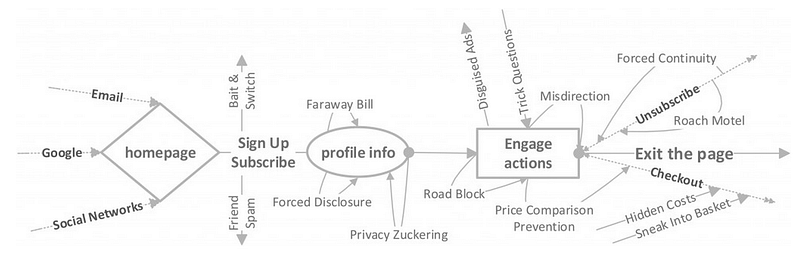Dark Side of the Curve
Who wins? Users or Growth?
Aaron Batalion and Arin Sarkissian are obsessed with podcasts. Last week, over a donut, they were suggesting podcasts and apps to me like the proverbial drug dealer.
“Try just one, Micah. What’s it going to hurt?” They would say. “There are a couple of really smart podcasts,” they intoned.
“Have you seen the apps? They are really well done.”
And, as we all seem to do, we succumb and download.
One of the apps, Stitcher, was particularly interesting because of its integration with Sonos, and it use of friend’s activity for discovery.
As I do with most apps, I tapped on Find Friends and was presented with this screen (its pulled from Contacts):

The first thing you will notice is that “Find Friends” (which continues to be the title of the screen) became “Invite Friends” (the forced action). But that is not nearly the most nefarious thing on this screen.
Where is the back button?
In design is the practice known as a Dark Pattern.
A Dark Pattern is a type of user interface that appears to have been carefully crafted to trick users into doing things, such as buying insurance with their purchase or signing up for recurring bills. — DarkPattern.org

Dark patterns are a common “Forgiveness not Permission” growth hack, where the hope is that the fallout from the hack itself is less than the benefit of the users gained.
Insta-Follow (Pinterest), Friend Spam (Facebook Apps) and Auto-Tweeting (tons of mobile apps) are other examples of this type of hack.
So it happens. Everyone on the internet knows this. But why?

We do it because we raise money and expectations and so the success horizon shortens. Because that first hype made us—and the people around us—taste a modicum of success, and now we just want more. Always more.
Every consumer startup reaches a point where the discussion becomes growth vs. user experience. Do we buy downloads? Do we focus on growth? We can always retain enough of the users we get to make it worthwhile.
At least thats what we believe.
It is a lie.
Users are everything.
Years ago, I was pretty good at SEO. I built a company around it and even some software. In talking with customers, the battle always was high traffic vs valuable traffic.
Growth hackers haven’t been exempted from that conversation. The expectation of a “great” growth hacker is that they can drive insane amounts of traffic. For free. That pressure is increased in a ventured backed company where hypergrowth is a requirement.
Where is the happy medium? Without growth, the app fails. With misguided growth, the app fails. (Don’t believe me? Check out Viddy.)
First and foremost, don’t lie to your users.
Never compromise user trust for user growth.
Second, don’t lie to your users.
Growth can be managed and accelerated by creating an environment where your users want to share their experiences with their networks. Reduce all the friction for this sharing. Make it simple, remind them often that it’s simple to share, and reward them for sharing by making them feel good about having their friends enjoy the experience.
Third, don’t lie to your users.
There is no need for dark patterns. They make users feel stupid and erode the trust your app needs to build, and while the early success may be intoxicating, over time growth, and success, will stagnate and die.
Users matter over everything.
